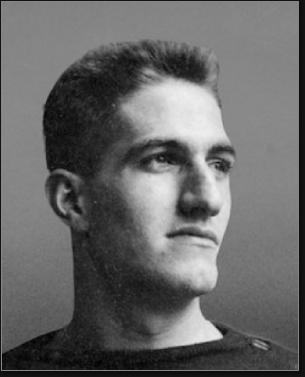
Sport: Football
Born: December 16, 1892
Died: February 1, 1977
Town: Bernardsville, New Jersey
Robert Arthur Nash was born December 16, 1892 in Collinstown, County Meath in the eastern part of Ireland. Bob came to the United States at the age of four. His family lived in Lake Forest, Illinois before moving to Bernardsville, NJ. Tall, muscular and aggressive, he gravitated to football at Bernards High and was a dominant two-way lineman. He attended Cornell briefly in 1911 before moving back to New Jersey and enrolling at Rutgers. He was part of a formidable line and was a second-team All-American in 1914. In 1915, his understudy was a freshman who would go on to become an All-American, too: Paul Robeson. That year Bob earned the nickname “Nasty.” Bob played basketball and baseball and competed for the track team at Rutgers, winning a total of 11 varsity letters.
After graduating in 1916, Bob worked for a streetcar company in upstate New York, but the pull of pro football proved irresistible. The following fall, he joined the Massillon Tigers, who fielded a squad featuring former stars from Notre Dame, Minnesota and other major Midwest schools. Their arch-rivals were the Canton Bulldogs, starring Jim Thorpe. Bob was one of the few players who could prevent Thorpe from turning the corner on end runs and took great delight in the look on the Olympian’s face after dragging him down. Like most pros in the pre-NFL era, Bob worked Monday to Friday and then took the train to weekend games. He earned a reputation as a great kick-coverage man and one of the best offensive tackles and defensive ends of his era.
Near the conclusion of World War I, Bob served as an ensign aboard the USS Cayuga. When he returned, he was promoted to player-coach of the Tigers in 1919. He and Knute Rockne played on opposite ends of the line. The quarterback was Rockne’s Notre Dame teammate, Gus Dorias. Also on the team were Fritz Pollard and future college coaching icons Jock Sutherland and Lou Little. Despite all this talent, they lost to Canton in the season’s big game, 3–0, on a 50-yard drop-kick field goal by Thorpe.
Bob signed with the Akron Pros in 1920 in the formative first season of the NFL, which at the time was called the American Pro Football Association (APFA). Near the end of the year, he was sold to the Buffalo All-Americans for $300 in what is regarded as the NFL’s first-ever player transaction. Also in 1920, Bob had an epic collision with Thorpe on a kick return that resulted in both stars being carted off the field. The Pros and the All-Americans were two of the best teams in the APFA in 1920. Instantly recognizable for his thick, broad moustache by this time, Bob earned All-Pro recognition in 1921.
Bob stayed with Buffalo through 1923. After a season with the 0–7 Rochester Jeffersons in 1924, he joined the New York Giants in 1925, their first NFL season. Coach Bob Folwell anointed him team captain. The team went 8–4 that year. Now in his 30s, Bob decided it was time to hang up the pads. In 16 years of rough-and-tumble football stretching back to high school, he had missed just two games.
After football, Bob returned to upstate New York and worked for General Motors. He later ran car dealerships in Manhattan and New Jersey. Bob moved to Connecticut in his retirement in the late-1950s. When the Giants opened the Meadowlands in 1976, Bob was one of the old-time Giants invited to take part in the on-field christening ceremony.
Bob often reminisced about his days as a two-way powerhouse, “lowering the boom on a wise-guy halfback and the fierce bocks down the field.” He passed away in 1977. In 1988, Bob was part of the first class inducted into the Rutgers Athletic Hall of Fame, along with his teammate Robeson and football legends Homer Hazel, Alex Kroll, Bill Pellington and Billy Austin.